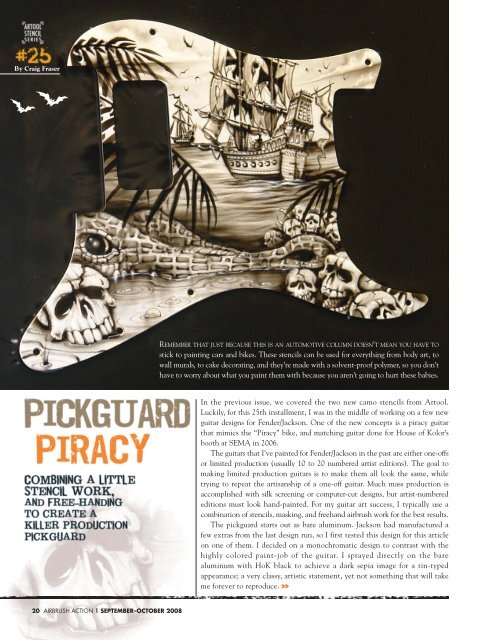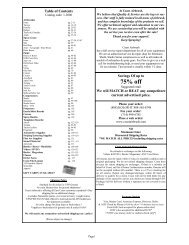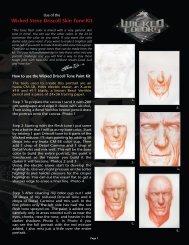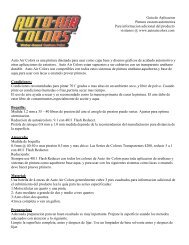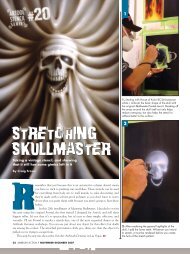airbrush action how to article 2 - Coast Airbrush
airbrush action how to article 2 - Coast Airbrush
airbrush action how to article 2 - Coast Airbrush
Create successful ePaper yourself
Turn your PDF publications into a flip-book with our unique Google optimized e-Paper software.
By Craig Fraser<br />
aa<br />
20 AIRBRUSH ACTION | SEPTEMBER–OCTOBER 2008<br />
REMEMBER THAT JUST BECAUSE THIS IS AN AUTOMOTIVE COLUMN DOESN’T MEAN YOU HAVE TO<br />
stick <strong>to</strong> painting cars and bikes. These stencils can be used for everything from body art, <strong>to</strong><br />
wall murals, <strong>to</strong> cake decorating, and they’re made with a solvent-proof polymer, so you don’t<br />
have <strong>to</strong> worry about what you paint them with because you aren’t going <strong>to</strong> hurt these babies.<br />
In the previous issue, we covered the two new camo stencils from Ar<strong>to</strong>ol.<br />
Luckily, for this 25th installment, I was in the middle of working on a few new<br />
guitar designs for Fender/Jackson. One of the new concepts is a piracy guitar<br />
that mimics the “Piracy” bike, and matching guitar done for House of Kolor’s<br />
booth at SEMA in 2006.<br />
The guitars that I’ve painted for Fender/Jackson in the past are either one-offs<br />
or limited production (usually 10 <strong>to</strong> 20 numbered artist editions). The goal <strong>to</strong><br />
making limited production guitars is <strong>to</strong> make them all look the same, while<br />
trying <strong>to</strong> repeat the artisanship of a one-off guitar. Much mass production is<br />
accomplished with silk screening or computer-cut designs, but artist-numbered<br />
editions must look hand-painted. For my guitar art success, I typically use a<br />
combination of stencils, masking, and freehand <strong>airbrush</strong> work for the best results.<br />
The pickguard starts out as bare aluminum. Jackson had manufactured a<br />
few extras from the last design run, so I first tested this design for this <strong>article</strong><br />
on one of them. I decided on a monochromatic design <strong>to</strong> contrast with the<br />
highly colored paint-job of the guitar. I sprayed directly on the bare<br />
aluminum with HoK black <strong>to</strong> achieve a dark sepia image for a tin-typed<br />
appearance; a very classy, artistic statement, yet not something that will take<br />
me forever <strong>to</strong> reproduce. >>
1. Bare aluminum substrates must be sanded clean first <strong>to</strong> increase<br />
adhesion. I also sprayed a light coat of House of Kolor (HoK) AP-01<br />
Adhesion Promoter <strong>to</strong> further bolster the adhesion of the basecoat <strong>to</strong> the<br />
aluminum. It will even survive direct masking. Aluminum can be very<br />
unfriendly <strong>to</strong> <strong>airbrush</strong>ing. And because pickguards receive a fair amount<br />
of abuse the end result must be durable. After the AP-01 dried, I sketched<br />
my basic concept on<strong>to</strong> the surface with a pencil. Draw very lightly so it<br />
won’t s<strong>how</strong> up later through the artwork.<br />
1 2<br />
2. Because the pickguard is so small, I used Ar<strong>to</strong>ol’s Mini Series version of<br />
stencils, which are literally half the size of the originals (the minis are also<br />
killer for use on RC cars, golf clubs, and helmets, <strong>to</strong>o). With the horizon<br />
line lightly <strong>airbrush</strong>ed in (that’s what the green tape in the previous pic was<br />
for), I used the Flying Dutchman stencil from the new Piracy series. This<br />
gave me a couple of killer pirate ship designs for the background. No<br />
need <strong>to</strong> hammer these stencils with paint; I’ll detail them later. I used overreduced<br />
BC-15 black in an Iwata Kus<strong>to</strong>m Micron C <strong>airbrush</strong>.<br />
www.<strong>airbrush</strong><strong>action</strong>.com 21
3. Using the Fronds stencil from the FX-4 line, I <strong>airbrush</strong>ed some greenery.<br />
Having the palm fronds coming in from outside the picture lends the<br />
overall image a sense of depth, and frames the piece nicely. Plus,<br />
greenery can be a good space filler. Because the palm trees are in the<br />
foreground, I made them exceptionally black. Barring connecting some of<br />
the leaves <strong>to</strong> the stalk, these are done.<br />
5. Using the Gater stencil, also from FX-4, I <strong>airbrush</strong>ed gater skin on the<br />
alliga<strong>to</strong>r and will finish rendering that later. The overall shape of the<br />
alliga<strong>to</strong>r was sketched in the first step. I’m very careful not <strong>to</strong> <strong>airbrush</strong> the<br />
stencil outside of the pencil lines, but any accidental overspray can be<br />
easily rendered in<strong>to</strong> rippled water.<br />
7. The alliga<strong>to</strong>r was next. A little detail work, some shading and<br />
shadows, and it’s starting <strong>to</strong> look like a dragon. Although I’ll be back<br />
later with white for highlights, I don’t want <strong>to</strong> depend on the white for<br />
repairs or fill-in. So, I needed <strong>to</strong> be very minimal with my <strong>airbrush</strong>ing,<br />
and leave as much aluminum s<strong>how</strong>ing as possible. This will give the end<br />
piece a very cool anodized-metal look when cleared.<br />
22 AIRBRUSH ACTION | SEPTEMBER–OCTOBER 2008<br />
3<br />
4. Next, I wanted <strong>to</strong> <strong>airbrush</strong> some skulls. Afterall, what’s a pirate<br />
mural without skulls, right? I <strong>airbrush</strong>ed larger skulls on the right and left<br />
sides of the foreground and added smaller ones <strong>to</strong> the background.<br />
You’ll notice that this helps establish a sense of depth. Up <strong>to</strong> now, I’m<br />
merely sketching and composing the design with stencils.<br />
5 6<br />
6. With the stencil work finished, I started the freehand fun. Using the<br />
same <strong>airbrush</strong>, I added a bit more RU-311 reducer <strong>to</strong> the mix <strong>to</strong> reduce<br />
any spitting, and <strong>to</strong> allow for more gradated shading. I began on the<br />
skull. Just a little detail work and some shading, and you can’t tell that the<br />
skull was done with a stencil.<br />
7 8<br />
8. Switching gears, I used a homemade stencil <strong>to</strong> add some of the soft<br />
lines for the water effect. The whiskbroom stencil is an oldie but a goody.<br />
Basically, I just cut off a bunch of whiskbroom straws and randomly tape<br />
them <strong>to</strong>gether. This type of stencil is great for grass, hair, water, fire<br />
effects, and more.<br />
4
9. Time <strong>to</strong> start detailing the pirate ships. Most of the work here is<br />
connecting the stencil lines and then adding a few more of my own. A<br />
few clouds in the sky, a couple of birds, and the mural is really starting <strong>to</strong><br />
come <strong>to</strong>gether. Remember not <strong>to</strong> make any of the areas <strong>to</strong>o dark<br />
because there’s no turning back with aluminum, and you really don’t<br />
want <strong>to</strong> sand or scratch the paint as a removal technique.<br />
aa<br />
FINAL<br />
As you can see, the monochromatic effect<br />
has a very cool look, especially with the<br />
aluminum underneath. Certainly, the<br />
terrific benefit <strong>to</strong> using stencils is the<br />
ability <strong>to</strong> create an entire piece fairly<br />
simply, quickly, and accurately. And this is<br />
key for most production <strong>airbrush</strong> work. I<br />
need the ease and continuity without<br />
compromising the look or sense of handcraftsmanship.<br />
Typically, for numbered<br />
editions, I’ll make slight design changes,<br />
and incorporate the number of the edition<br />
in<strong>to</strong> the design. This makes the piece look<br />
less assembly-line, and more unique than<br />
other production pieces.<br />
Paint <strong>to</strong> live, live <strong>to</strong> paint, and<br />
sometimes on guitars. – Fraser<br />
9<br />
10<br />
10. The final step is reserved for the white highlights. With BC-26 HoK<br />
over-reduced by 200%, and with a bit of SG-100 added, the white is thin<br />
enough <strong>to</strong> be translucent and help reduce spitting when working on fine<br />
details. I only use this white for the thinnest and brightest highlights. Any<br />
more, and the overspray from the white will kill the effect. Just a little creates<br />
a very cool 3-D effect once cleared and viewed from different angles.<br />
aa<br />
Craig Fraser has been <strong>airbrush</strong>ing for more<br />
than twenty years, is the owner of Air<br />
Syndicate Inc., and, since 1992, has been<br />
the in-house <strong>airbrush</strong> artist and designer for<br />
Kal Koncepts, of Bakersfield, California. Kal<br />
Koncepts/Air Syndicate specializes in<br />
au<strong>to</strong>motive kus<strong>to</strong>m graphics and the fine art<br />
of the Kus<strong>to</strong>m Kulture. Craig divides his time<br />
between the shop, teaching workshops (the<br />
esteemed <strong>Airbrush</strong> Getaway, House of Kolor,<br />
<strong>Coast</strong> <strong>Airbrush</strong>), and writing <strong>article</strong>s. He’s<br />
also the author of Au<strong>to</strong>motive Cheap Tricks<br />
and Special F/X, and the star of 15<br />
instructional DVDs on kus<strong>to</strong>m painting<br />
techniques. You may view more of Fraser’s<br />
artwork at www.gotpaint.com.<br />
www.<strong>airbrush</strong><strong>action</strong>.com 23


